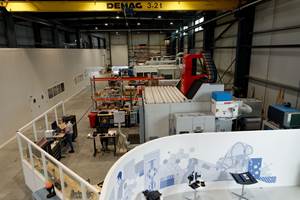If we recycle it, will they come?
Thanks to the 787 and the A350 XWB aircraft programs, the composites industry has more scrap carbon fiber prepreg than it knows what to do with. At least, not yet.

Thanks to the 787 and the A350 XWB aircraft programs, the composites industry has more scrap carbon fiber prepreg than it knows what to do with. At least, not yet.
The Institute for Advanced Composites Manufacturing Innovation (IACMI, Knoxville, TN, US), the public/private consortium created to accelerate the evolution of composites technologies in automotive, wind, pressure vessels, design engineering and manufacturing processes, is six months old and in January hosted its second membership meeting in Detroit, MI, US, to coincide with the North American International Auto Show (NAIAS).
The meeting — a “where are we now” update on the consortium’s progress — gathered 290 members, representing every stratum of the composites industry, including suppliers, OEMs, academicians and government officials.
In terms of size (US$259 million in public and private funds), scope and ambition, IACMI is a first-of-its-kind organization for the American composites industry, and it has set some decidedly ambitious goals, ranging from dramatically reducing the cost of carbon fiber manufacture to development of automated, high-speed manufacturing processes for wind energy and automotive applications.
It is, thus, understandable that some members — despite already having invested in the consortium — exhibited skepticism about its viability. Indeed, during breaks at the Detroit meeting, it was not uncommon to be asked, “So, what do you think? Does this thing have a chance?”
If the first six months of progress represent what is to come, I, for one, am optimistic. There are, at IACMI’s helm, people passionate and knowledgeable about composites manufacturing, and clearly dedicated to seeing the consortium sustain itself beyond the initial five-year funding window. Already, IACMI is investing in substantial development work that proves this is not a government-sponsored boondoggle (for a full report on the meeting, visit short.compositesworld.com/IACMI16).
Most of IACMI’s goals, although ambitious, strike me as realistic and, if achieved, could move the composites industry forward substantially in terms of efficiency, manufacturing quality and cost. There is one goal, however, that, to be met, will require not just money and effort and creativity, but the creation of an entirely new end-market. By 2020, 80% of all glass and carbon fiber composite parts must be recyclable, and by 2025, >95% of those parts must be recyclable.
We have the technology, today, to recycle cured and uncured composite materials of many types. In this sense, nearly every composite part is already “recyclable,” and could be recycled with an investment in the capital and equipment required for the task. But it’s one thing to assume that the part eventually will be recyclable, but quite another to presume that it, in fact, will be recycled and reused in one of a host of applications designed to consume used or non-virgin fiber. And that’s the rub. There is, today, no “host of applications” waiting for the wave of recycled fiber that will, if IACMI succeeds, flood the market.
Creating that host of applications will be no trivial undertaking. Recycled fiber must first be tested and characterized. Is it glass or carbon? Is it chopped? If so, how long are the fibers? What are the strength and stiffness properties? These properties then must be matched up with potential applications. Further, given the volume of used material that conceivably could be made available, it will probably be necessary for some large OEMs — Boeing, Airbus, Ford, Toyota, etc. — to step up and commit to an effort to find a use for recycled fibers, like BMW has done with its i3 roof.
One step in the right direction can be found this month in "Recycled carbon fiber proves its potential for aircraft interiors," a story written by senior editor Ginger Gardiner about use of recycled carbon fiber by Airbus in an aircraft interiors R&D program (read more by clicking on its title under "Editor's Picks" at top right). A successful recycling industry, however, will require thousands of efforts like this one. And soon.
The bottom line is this: The composites industry’s expansion is creating a waste stream for which we all must take responsibility. I hope that IACMI’s edict will provide the spark we need.
Related Content
Plant tour: Daher Shap’in TechCenter and composites production plant, Saint-Aignan-de-Grandlieu, France
Co-located R&D and production advance OOA thermosets, thermoplastics, welding, recycling and digital technologies for faster processing and certification of lighter, more sustainable composites.
Read MoreWatch: A practical view of sustainability in composites product development
Markus Beer of Forward Engineering addresses definitions of sustainability, how to approach sustainability goals, the role of life cycle analysis (LCA) and social, environmental and governmental driving forces. Watch his “CW Tech Days: Sustainability” presentation.
Read MoreCirculinQ: Glass fiber, recycled plastic turn paving into climate solutions
Durable, modular paving system from recycled composite filters, collects, infiltrates stormwater to reduce flooding and recharge local aquifers.
Read MoreJEC World 2023 highlights: Recyclable resins, renewable energy solutions, award-winning automotive
CW technical editor Hannah Mason recaps some of the technology on display at JEC World, including natural, bio-based or recyclable materials solutions, innovative automotive and renewable energy components and more.
Read MoreRead Next
Developing bonded composite repair for ships, offshore units
Bureau Veritas and industry partners issue guidelines and pave the way for certification via StrengthBond Offshore project.
Read MoreVIDEO: High-volume processing for fiberglass components
Cannon Ergos, a company specializing in high-ton presses and equipment for composites fabrication and plastics processing, displayed automotive and industrial components at CAMX 2024.
Read MorePlant tour: Daher Shap’in TechCenter and composites production plant, Saint-Aignan-de-Grandlieu, France
Co-located R&D and production advance OOA thermosets, thermoplastics, welding, recycling and digital technologies for faster processing and certification of lighter, more sustainable composites.
Read More












.jpg;maxWidth=300;quality=90)








